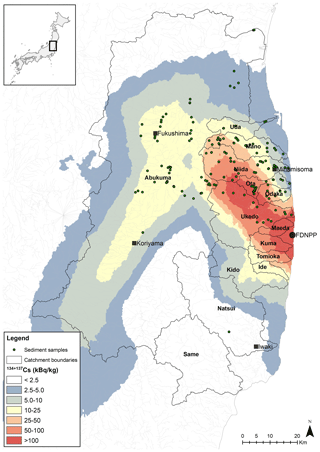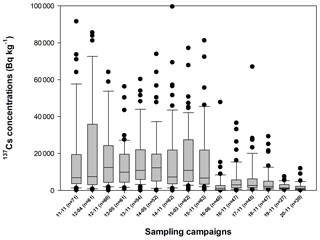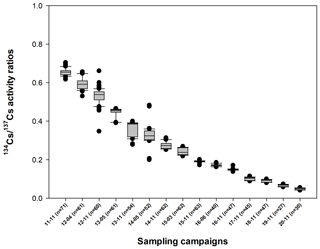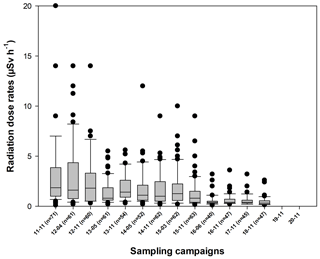the Creative Commons Attribution 4.0 License.
the Creative Commons Attribution 4.0 License.
Radionuclide contamination in flood sediment deposits in the coastal rivers draining the main radioactive pollution plume of Fukushima Prefecture, Japan (2011–2020)
Olivier Evrard
Caroline Chartin
J. Patrick Laceby
Yuichi Onda
Yoshifumi Wakiyama
Atsushi Nakao
Olivier Cerdan
Hugo Lepage
Hugo Jaegler
Rosalie Vandromme
Irène Lefèvre
Philippe Bonté
Artificial radionuclides including radiocesium (134Cs and 137Cs) and radiosilver (110mAg) were released into the environment following the Fukushima Dai-ichi nuclear power plant accident in March 2011. These particle-bound substances deposited on soils of north-eastern Japan, located predominantly within a ∼3000 km2 radioactive fallout plume and drained by several coastal rivers to the Pacific Ocean. The current dataset (Evrard et al., 2021), which can be accessed at https://doi.org/10.1594/PANGAEA.928594, compiles gamma-emitting artificial radionuclide activities measured in 782 sediment samples collected from 27 to 71 locations across catchments draining ∼6450 km2 during 16 fieldwork campaigns. These campaigns were conducted in Japan between November 2011 and November 2020 in river catchments draining the main radioactive plume. This database may be useful to evaluate and anticipate the post-accidental redistribution of radionuclides in the environment and for the spatial validation of models simulating the transfer of radiocesium across continental landscapes.
- Article
(3777 KB) - Full-text XML
- BibTeX
- EndNote
The accident that occurred in March 2011 at the Fukushima Dai-ichi nuclear power plant (FDNPP) released large quantities of radionuclides into the environment (Leelossy et al., 2011). Among the radioactive substances emitted, two radiocesium isotopes (134Cs and 137Cs) are the most problematic over the medium to long term as they were released in abundant quantities (Shozugawa et al., 2012). Furthermore, they are characterized by relatively long half-lives (2 years for 134Cs and 30 years for 137Cs), which may cause their persistence in the environment (Evrard et al., 2015). Both radiocesium isotopes were released in equivalent proportions during the accident, with initial 134Cs:137Cs activity ratios close to 1 (Kobayashi et al., 2017). Other artificial radionuclides such as silver-110 metastable (110mAg) – an activation product of 109Ag found in control rods or in the alloy used to seal the head of the reactor – were found in the environment in the vicinity of the FDNPP (Le Petit et al., 2012).
Radiocesium deposition on soils of the Fukushima Prefecture generated the formation of a ∼3000 km2 radioactive pollution plume extending to the north-west of the FDNPP (Yasunari et al., 2011). Radiocesium and radiosilver were shown to have a strong affinity for the fine mineral fractions (typically the clay- and silt-sized fractions) of these soils (Fan et al., 2014; Lepage et al., 2014; Nakao et al., 2014). However, these substances have also been found in coarser particle fractions including sand-sized material (Tanaka et al., 2014). As the soils located in the main radioactive pollution plume are drained by several coastal river systems to the Pacific Ocean, the redistribution of the initial contamination through water erosion and riverine sediment transfer processes was anticipated (Evrard et al., 2015; Onda et al., 2020).
This region of north-eastern Japan is exposed to frequent heavy rainfall events, including typhoons, occurring mainly during summer and early in autumn (Laceby et al., 2016a). These events often generate extensive soil erosion and flooding in the region (Evrard et al., 2020). They therefore provide a significant mechanism redistributing the radioactive contamination from the soils exposed to the initial fallout to the Pacific Ocean after transiting these coastal river systems (Nagao et al., 2013; Evrard et al., 2014).
Monitoring the spatial and the temporal redistribution of this radioactive contamination transported with sediment during the post-accident period is therefore crucial to improve our understanding of soil erosion and sediment transfer processes in rivers exposed to frequent typhoons and to evaluate the effectiveness of remediation measures. In Fukushima, decontamination mainly consisted of removing the topsoil layer, concentrating fallout radionuclides and replacing it with a new substrate devoid of artificial radionuclides (Evrard et al., 2019c).

Figure 1Location of the sediment samples collected between 2011–2020 in the river catchments draining the main radioactive plume near the FDNPP. Background map of initial radiocesium concentrations after Chartin et al. (2013).
To conduct this spatial and temporal monitoring, sediment samples were collected systematically at various locations in the coastal catchments draining the main radioactive pollution plume to characterize the evolution of the radioactive contamination transiting these rivers between 2011 and 2020. The data described here were partly used in previous publications to investigate the potential changes in sources (i.e. soil types (Lepage et al., 2016), land use types (Laceby et al., 2016b; Evrard et al., 2019b, a; Huon et al., 2018) and surface material vs. subsoil (Evrard et al., 2016)) supplying material to the rivers. The current database provides the gamma-emitting radionuclide activities measured in these sediment deposits along with the radioactive dose rates measured in the river channel and in the nearby soils during these surveys. This dataset provides a unique and uniform data compilation collected using consistent sampling and internationally calibrated gamma analysis methods throughout the first decade (2011–2020) that followed the FDNPP accident. It provides a useful complement to the 6-year dataset (2011–2017) of radiocesium fluxes analysed in sediment draining the Fukushima radioactive plume (Taniguchi et al., 2020).
The dataset (Evrard et al., 2021) includes the following fields for each
record:
| LABEL | Sample name |
| SAMPLING DATE | Sampling date used as reference date for radionuclide decay correction |
| ANALYSIS DATE | Date of gamma spectrometry analysis |
| CAMPAIGN | Number of fieldwork campaign (from 1 to 16; campaign 12 was canceled due to flood occurrence) |
| RIVER | Name of the river catchment where the sample was collected |
| LATITUDE | Latitude (WGS 1984) |
| LONGITUDE | Longitude (WGS 1984) |
| DOSE RATE SOIL | Radioactive dose rate measured on soils near the river (µSv h−1) |
| DOSE RATE RIVER | Radioactive dose rate measured on recent sediment deposits in the river channel (µSv h−1) |
| CS-137 | 137Cs concentration analysed by gamma spectrometry (Bq kg−1) |
| CS-134 | 134Cs concentration analysed by gamma spectrometry (Bq kg−1) |
| AG-110M | 110mAg concentration analysed by gamma spectrometry (Bq kg−1) |
Sixteen sediment sampling campaigns (numbered from 1 to 16) were organized between November 2011 and November 2020. Sampling occurred bi-annually (i.e. in autumn after the typhoon season and in spring, after the snowmelt run-off) between November 2011 and November 2016. Then, the campaigns occurred after the typhoon season late in October or early in November between 2017 and 2020 at 27 to 71 locations. Sediment could not be collected during campaign 12 (spring 2017) because of the occurrence of a flood leading to the resuspension of sediment in the water column during that period.

Figure 2Evolution of 137Cs concentrations in river sediment samples collected in the river catchments draining the main radioactive plume near the FDNPP between November 2011 and November 2020 (all activities were decay-corrected to the sampling date).
In total, 782 sediment samples were collected in river catchments draining the main radioactive plume (Fig. 1). Fine sediment samples were taken from material deposited after the last major event at the same sites during each of the 15 campaigns. These lag deposit samples were comprised of fine particulate material that settled on channel banks, inset benches and floodplains during the falling limb of the last significant hydro-sedimentary event. Ten subsamples (∼20 g per subsample) of the uppermost (top 2 cm layer) recently deposited material were taken with a plastic spatula over a 5 m reach (across a surface area of ∼20 to 50 m2) and composited into one sample after mixing in a bucket. In the field, radiation dose rates were systematically measured at 1 cm height using a radiometer (LB123 D-H10, Berthold Technologies) in recent sediment drape deposits and in nearby soils along rivers (i.e. in a 10 to 20 m wide area along rivers).
All samples were dried at 40 ∘C for ∼48 h, sieved to 2 mm, disaggregated and pressed into 15 mL polyethylene containers for analysis. Gamma-emitting radionuclide activities were determined by gamma spectrometry using low-background coaxial HyperPure germanium detectors (Canberra and Ortec). Samples were analysed for 30 000 to 200 000 s. 137Cs activities were measured at the 662 keV emission peak. 134Cs activities were calculated as the mean of activities measured at both 604 and 795 keV emission peaks. Although the presence of 110mAg in a sample was confirmed when peaks were detected at 885, 937 and 1384 keV simultaneously, the activities in this radionuclide were calculated from the 885 keV peak only. All radionuclide activities were decay-corrected to the sampling date. Errors reached ca. 5 %–10 % in 134Cs and 137Cs activities and ca. 15 %–20 % in 110mAg activities at the 95 % confidence level. All measured counts were corrected for background levels measured at least every 2 months as well as for detector and geometry efficiencies. Results were systematically expressed in Bq kg−1 of dry weight. Quality assurance was conducted using certified International Atomic Energy Agency (IAEA) reference materials (i.e. IAEA-444, IAEA-375) as well as a multi-gamma resin produced by the IRSN (Institut de Radioprotection et de Sûreté Nucléaire, France), with elevated 137Cs (160 000 Bq kg−1; reference date: 7 January 2011) and 134Cs activities (330 000 Bq kg−1) prepared in the same containers as the samples.

Figure 3Evolution of 137Cs:134Cs activity ratios in river sediment samples collected in the river catchments draining the main radioactive plume near the FDNPP between November 2011 and November 2020 (all activities were decay-corrected to the sampling date).
Overall, 137Cs activities decreased by 93 % in sediment during the monitoring period, from a mean of 28 516 Bq kg−1 (range: 126–715 647 Bq kg−1) in 2011 to a mean of 2115 Bq kg−1 in 2020 (range: 68–11 928 Bq kg−1; Fig. 2). This decreasing trend is consistent despite the strong spatial variations due to the heterogeneity of the initial radioactive contamination levels (Fig. 1). The decrease in 137Cs activities throughout time mainly occurred after the occurrence of Typhoon Etau in 2015, with mean 137Cs activities declining from 20 397 Bq kg−1 in November 2015 to 3419 Bq kg−1 in June 2016. This period also coincided with the occurrence of widespread decontamination works in the region (Evrard et al., 2016). The occurrence of Typhoon Hagibis in October 2019 generally led to more abundant rainfall (range: 77–558 mm) across the Fukushima region than Typhoon Etau in 2015 (range: 41–458 mm). However, Typhoon Hagibis (on 11–12 October 2019) and the subsequent Tropical Storm Bualoi on 24–25 October 2019) did not lead to such a large decline in 137Cs activities in sediment as Typhoon Etau, although these radionuclide levels decreased from a mean of 4808 Bq kg−1 in October 2018 to a mean of 2167 Bq kg−1 in October 2019. This is likely explained by the fact that sediment transported during the flooding events in 2019 mainly originated from decontaminated soils prepared for recultivation, which were already depleted in radiocesium (Evrard et al., 2020). Then, in the absence of a major typhoon occurrence in 2020, 137Cs activities remained stable between 2019 (mean: 2167 Bq kg−1) and 2020 (mean: 2115 Bq kg−1).
During the 2011–2020 monitoring period, 134Cs activities in sediment decayed rapidly, with 134Cs:137Cs activity ratios decreasing from a mean of 0.66 (standard deviation – SD: 0.04) in November 2011 to a mean of 0.05 (SD: 0.01) in November 2020 (Fig. 3).
Because of an even more rapid radioactive decay (half-life of ∼250 d), 110mAg activities in sediment were no longer detected after May 2013. This absence of detection from 2013 onwards is also due to the emission of 110mAg in much lower abundance compared to 137Cs. Indeed, 110mAg:137Cs activity ratios between 0.002–0.010 (decay-corrected to March 2011) were measured in soils and sediment of the main plume, which could be used during the early post-accidental conditions (2011/12) to investigate the dispersion of the radioactive contamination in the coastal rivers (Lepage et al., 2014).
The decrease in radioactive contamination with time measured in the sediment was also reflected by a strong decrease in the radioactive decrease in the ambient dose rates (Fig. 4), from a mean of 3.3 µSv h−1 (range: 0.1–40 µSv h−1) in November 2011 to a mean of 0.5 µSv h−1 (range: 0.1–2.6 µSv h−1) in November 2018. From 2019 onwards, the radiation dose rates emitted by recent sediment deposits and nearby soils could no longer be distinguished from the general background signal, and measurements were therefore no longer conducted during the last two fieldwork campaigns in 2019 and 2020. The strong decrease in 137Cs activities observed after the occurrence of Typhoon Etau in 2015 (Fig. 2) is also reflected by a significant decline in radioactive dose rates measured on recent sediment deposits (mean of 0.6 µSv h−1 in June 2016 compared to a mean of 1.3 µSv h−1 in November 2015; Fig. 4).
The data (Evrard et al., 2021) are archived at https://doi.org/10.1594/PANGAEA.928594.
This database compiles radiocesium (and radiosilver during the early post-accidental stage) activities analysed in recent sediment deposits collected following a homogeneous protocol in the coastal catchments draining the main radioactive pollution plume in the Fukushima Prefecture, Japan. These results demonstrate that the radiocesium levels in sediment transiting these rivers decreased by more than 90 % between 2011–2020. This is confirmed by the similar decline (∼85 %) in radioactive dose rates observed in the field between 2011–2018. This dataset demonstrates the impact of the rapid decontamination of catchments exposed to accidental radioactive fallout in less than a decade, which will be useful for model output validation and for anticipating the fate of residual radionuclides in the environment. In the future, monitoring of radiocesium activities will continue in Fukushima coastal rivers in order to investigate the impact of recultivation of decontaminated areas on these transfers (Bourdet, 2021).
All the authors participated in (at least part of) the 16 sediment sampling campaigns (and the associated radioactive dose rate measurements) as well as in sample preparation in the laboratory. IL and PB conducted the gamma spectrometry analyses and the associated quality control. OE wrote the manuscript, and all co-authors provided feedback and revised the text. All the authors declare that this database is an original product of their collaborative work conducted in Fukushima coastal catchments since 2011. Although interpretations based on some of the data presented in the current paper have been published in previous publications of the group (see the references cited in the Introduction), the objective of the current data paper was to provide a unique and uniform database compiling all the radioactive dose rates and radionuclide concentrations measured by the Franco-Japanese consortium in sediment transiting coastal rivers draining the main radioactive plume during the first decade (2011–2020) that followed the FDNPP accident. The publication of this raw and unique data compilation should facilitate the dissemination of data acquired in these post-accidental conditions among the international community.
The authors declare that they have no conflict of interest.
The support of the CEA (Commissariat à l'Energie Atomique et aux Energies Alternatives, France), CNRS (Centre National de la Recherche Scientifique, France) and JSPS (Japan Society for the Promotion of Science) through the funding of PhD fellowships (Hugo Lepage, Hugo Jaegler) and collaboration projects (grant no. PRC CNRS JSPS 2019-2020, grant no. 10; CNRS International Research Project – IRP – MITATE Lab) is also gratefully acknowledged.
This research has been supported by the French National Research Agency (ANR, Agence Nationale de la Recherche) TOFU project (grant no. ANR-11-JAPN-001) and AMORAD project (grant no. ANR-11-RSNR-0002)
This paper was edited by David Carlson and reviewed by two anonymous referees.
Bourdet, J.: Learning from the Fukushima decontamination, available at: https://news.cnrs.fr/articles/learning-from-the-fukushima-decontamination, last access: 6 March 2021.
Chartin, C., Evrard, O., Onda, Y., Patin, J., Lefèvre, I., Ottlé, C., Ayrault, S., Lepage, H., and Bonté, P.: Tracking the early dispersion of contaminated sediment along rivers draining the Fukushima radioactive pollution plume, Anthropocene, 1, 23–34, https://doi.org/10.1016/j.ancene.2013.07.001, 2013.
Evrard, O., Chartin, C., Onda, Y., Lepage, H., Cerdan, O., Lefevre, I., and Ayrault, S.: Renewed soil erosion and remobilisation of radioactive sediment in Fukushima coastal rivers after the 2013 typhoons, Sci. Rep.-UK, 4, 4574, https://doi.org/10.1038/srep04574, 2014.
Evrard, O., Laceby, J. P., Lepage, H., Onda, Y., Cerdan, O., and Ayrault, S.: Radiocesium transfer from hillslopes to the Pacific Ocean after the Fukushima Nuclear Power Plant accident: A review, J. Environ. Radioactiv., 148, 92–110, https://doi.org/10.1016/j.jenvrad.2015.06.018, 2015.
Evrard, O., Laceby, J. P., Onda, Y., Wakiyama, Y., Jaegler, H., and Lefevre, I.: Quantifying the dilution of the radiocesium contamination in Fukushima coastal river sediment (2011–2015), Sci. Rep.-UK, 6, 34828, https://doi.org/10.1038/srep34828, 2016.
Evrard, O., Durand, R., Foucher, A., Tiecher, T., Sellier, V., Onda, Y., Lefèvre, I., Cerdan, O., and Laceby, J. P.: Using spectrocolourimetry to trace sediment source dynamics in coastal catchments draining the main Fukushima radioactive pollution plume (2011–2017), J. Soil. Sediment., 19, 3290–3301, https://doi.org/10.1007/s11368-019-02302-w, 2019a.
Evrard, O., Laceby, J. P., Ficetola, G. F., Gielly, L., Huon, S., Lefevre, I., Onda, Y., and Poulenard, J.: Environmental DNA provides information on sediment sources: A study in catchments affected by Fukushima radioactive fallout, Sci. Total Environ., 665, 873–881, https://doi.org/10.1016/j.scitotenv.2019.02.191, 2019b.
Evrard, O., Laceby, J. P., and Nakao, A.: Effectiveness of landscape decontamination following the Fukushima nuclear accident: a review, SOIL, 5, 333–350, https://doi.org/10.5194/soil-5-333-2019, 2019c.
Evrard, O., Durand, R., Nakao, A., Patrick Laceby, J., Lefèvre, I., Wakiyama, Y., Hayashi, S., Asanuma-Brice, C., and Cerdan, O.: Impact of the 2019 typhoons on sediment source contributions and radiocesium concentrations in rivers draining the Fukushima radioactive plume, Japan, Comptes Rendus Géoscience, 352, 199–211, https://doi.org/10.5802/crgeos.42, 2020.
Evrard, O., Chartin, C., Laceby, J. P., Onda, Y., Wakiyama, Y., Nakao, A., Cerdan, O., Lepage, H., Jaegler, H., Vandromme, R., Lefèvre, I., and Bonté, P.: Radioactive dose rates and fallout radionuclide activities in sediment deposits along rivers draining the main Fukushima plume, Japan, PANGAEA, https://doi.org/10.1594/PANGAEA.928594, 2021.
Fan, Q., Yamaguchi, N., Tanaka, M., Tsukada, H., and Takahashi, Y.: Relationship between the adsorption species of cesium and radiocesium interception potential in soils and minerals: an EXAFS study, J. Environ. Radioactiv., 138C, 92–100, https://doi.org/10.1016/j.jenvrad.2014.08.009, 2014.
Huon, S., Hayashi, S., Laceby, J. P., Tsuji, H., Onda, Y., and Evrard, O.: Source dynamics of radiocesium-contaminated particulate matter deposited in an agricultural water reservoir after the Fukushima nuclear accident, Sci. Total Environ., 612, 1079–1090, https://doi.org/10.1016/j.scitotenv.2017.07.205, 2018.
Kobayashi, S., Shinomiya, T., Ishikawa, T., Imaseki, H., Iwaoka, K., Kitamura, H., Kodaira, S., Kobayashi, K., Oikawa, M., Miyaushiro, N., Takashima, Y., and Uchihori, Y.: Low 134CsCs ratio anomaly in the north-northwest direction from the Fukushima Dai-ichi Nuclear Power Station, J. Environ. Radioactiv., 178–179, 84–94, https://doi.org/10.1016/j.jenvrad.2017.07.023, 2017.
Laceby, J. P., Chartin, C., Evrard, O., Onda, Y., Garcia-Sanchez, L., and Cerdan, O.: Rainfall erosivity in catchments contaminated with fallout from the Fukushima Daiichi nuclear power plant accident, Hydrol. Earth Syst. Sci., 20, 2467–2482, https://doi.org/10.5194/hess-20-2467-2016, 2016a.
Laceby, J. P., Huon, S., Onda, Y., Vaury, V., and Evrard, O.: Do forests represent a long-term source of contaminated particulate matter in the Fukushima Prefecture?, J. Environ. Manage., 183, 742–753, https://doi.org/10.1016/j.jenvman.2016.09.020, 2016b.
Le Petit, G., Douysset, G., Ducros, G., Gross, P., Achim, P., Monfort, M., Raymond, P., Pontillon, Y., Jutier, C., Blanchard, X., Taffary, T., and Moulin, C.: Analysis of Radionuclide Releases from the Fukushima Dai-Ichi Nuclear Power Plant Accident Part I, Pure Appl. Geophys., 171, 629–644, https://doi.org/10.1007/s00024-012-0581-6, 2012.
Leelossy, A., Meszaros, R., and Lagzi, I.: Short and long term dispersion patterns of radionuclides in the atmosphere around the Fukushima Nuclear Power Plant, J. Environ. Radioactiv., 102, 1117–1121, https://doi.org/10.1016/j.jenvrad.2011.07.010, 2011.
Lepage, H., Evrard, O., Onda, Y., Patin, J., Chartin, C., Lefevre, I., Bonte, P., and Ayrault, S.: Environmental mobility of 110mAg: lessons learnt from Fukushima accident (Japan) and potential use for tracking the dispersion of contamination within coastal catchments, J. Environ. Radioactiv., 130, 44–55, https://doi.org/10.1016/j.jenvrad.2013.12.011, 2014.
Lepage, H., Laceby, J. P., Bonté, P., Joron, J.-L., Onda, Y., Lefèvre, I., Ayrault, S., and Evrard, O.: Investigating the source of radiocesium contaminated sediment in two Fukushima coastal catchments with sediment tracing techniques, Anthropocene, 13, 57–68, https://doi.org/10.1016/j.ancene.2016.01.004, 2016.
Nagao, S., Kanamori, M., Ochiai, S., Tomihara, S., Fukushi, K., and Yamamoto, M.: Export of 134Cs and 137Cs in the Fukushima river systems at heavy rains by Typhoon Roke in September 2011, Biogeosciences, 10, 6215–6223, https://doi.org/10.5194/bg-10-6215-2013, 2013.
Nakao, A., Ogasawara, S., Sano, O., Ito, T., and Yanai, J.: Radiocesium sorption in relation to clay mineralogy of paddy soils in Fukushima, Japan, Sci. Total Environ., 468–469, 523–529, https://doi.org/10.1016/j.scitotenv.2013.08.062, 2014.
Onda, Y., Taniguchi, K., Yoshimura, K., Kato, H., Takahashi, J., Wakiyama, Y., Coppin, F., and Smith, H.: Radionuclides from the Fukushima Daiichi Nuclear Power Plant in terrestrial systems, Nature Reviews Earth and Environment, 1, 644–660, https://doi.org/10.1038/s43017-020-0099-x, 2020.
Shozugawa, K., Nogawa, N., and Matsuo, M.: Deposition of fission and activation products after the Fukushima Dai-ichi nuclear power plant accident, Environ. Pollut., 163, 243–247, https://doi.org/10.1016/j.envpol.2012.01.001, 2012.
Tanaka, K., Iwatani, H., Sakaguchi, A., Fan, Q., and Takahashi, Y.: Size-dependent distribution of radiocesium in riverbed sediments and its relevance to the migration of radiocesium in river systems after the Fukushima Daiichi Nuclear Power Plant accident, J. Environ. Radioactiv., 139, 390–397, https://doi.org/10.1016/j.jenvrad.2014.05.002, 2014.
Taniguchi, K., Onda, Y., Smith, H. G., Blake, W., Yoshimura, K., Yamashiki, Y., and Kuramoto, T.: Dataset on the 6-year radiocesium transport in rivers near Fukushima Daiichi nuclear power plant, Sci. Data, 7, 433, https://doi.org/10.1038/s41597-020-00774-x, 2020.
Yasunari, T. J., Stohl, A., Hayano, R. S., Burkhart, J. F., Eckhardt, S., and Yasunari, T.: Cesium-137 deposition and contamination of Japanese soils due to the Fukushima nuclear accident, P. Natl. Acad. Sci. USA, 108, 19530–19534, https://doi.org/10.1073/pnas.1112058108, 2011.





